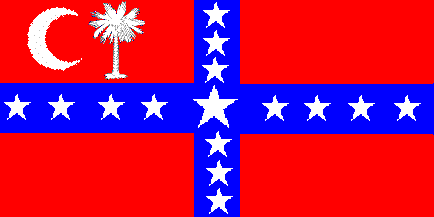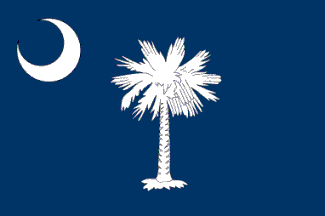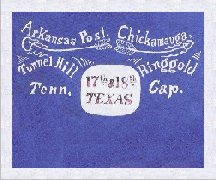There is a lot of misinformation and historical ignorance in today's America. One example of this historical ignorance is the current excising of "The" Confederate flag from the public sphere for political purposes. This is not the place to debate the fallacies or merits of that plan, but instead a time to recognize that people incorrectly believe that there was only one vexillological expression of the CSA. Instead, there were multiple flags used as national symbols; unofficial flags that represented the Confederacy or the South at large, and governmental department flags; and multiple versions of battle flags used as standards by military forces. Interestingly enough, the flag with the most public recognition as "
The Confederate Flag" is closest in design to one that was used by CSN vessels at sea, or to the Army of Tennessee.
First, a look at the national flags of the CSA.
The first national flag was known as the "Stars and Bars", and was used from 1861-1863. There were various versions of this flag with differing numbers of stars representing the states admitted to, or claimed by, the CSA.
The first version had 7 stars, representing the original 7 states of SC, MS, FL, AL, GA, LA, and TX. Later versions grew to 9, then 11 stars, as VA, AR, TN, and NC joined. The final version had 13 stars, which included the states of MO and KY. Although these last states are not officially considered to have left the Union, they were represented in the CSA as well. There are some versions known to have 15 stars as well, representing the other southern states of DE and MD.
First CSA national flag with 7 stars:
 First CSA national flag with 13 stars
First CSA national flag with 13 stars:

There was some dissatisfaction with the Stars and Bars, with concern that it too closely resembled the US flag. The Second CSA national flag was authorized in 1863, and was nicknamed the "Stainless Banner." It was simply the battle flag of the Army of Northern Virginia put on a white background.

The 3rd CS national flag modified the second version to address some complaints. In March of 1865, a red bar was placed at the end of the flag to reduce the risk of it being considered a flag of truce. This was nicknamed the "Blood Stained Banner," but was not in general use due to the collapse of the CSA a month later.

After looking at the official national flags, we can now examine some unofficial flags and governmental department flags.
First, the "Bonnie Blue" flag. It started off as the flag of the Republic of West Florida, later used by Texas and Mississippi, and some of the combatants at Fort Sumter.

The South Carolina Sovereignty Flag was popular in that state, and was ostensibly the basis for the Army of Northern Virginia battle flag. Notice what happens if you remove the crescent and palmetto, and change the St George cross to a cross saltire [change + to x]. Reputedly, this change was made to appease the sensibilities of the Jewish southern loyalist population.

Versions of flags with the palmetto tree on them were also popular in secessionist SC.
State flag:
 Palmetto Guard flag
Palmetto Guard flag:

The Confederate Navy used two different versions of the Navy Jack.
1st version (1861-1863):
 2nd version (1863-1865)
2nd version (1863-1865) [Note the rectangular shape of the flag, as opposed to the square version used in the national flags which was taken directly from the ANV battle flags. Reputedly, this version of the "Southern Cross" became popular in the 20th century because it was easier for flagmakers to work with rectangular instead of square flags. Some of the online sources also say that the Navy Jack had the St Andrews cross in a lighter shade of blue than the ANV version.]
 Hospital flag (yellow or red)
Hospital flag (yellow or red):
 Confederate States Revenue Service
Confederate States Revenue Service:

Finally, we can see examples of some battle flags, used to identify units, and also to make sure that the problems with the national flags (resembling the US flag or a truce flag) did not cause problems with misidentification on the battlefield. The Army of Northern Virginia pattern was not the only one used. There were several distinct styles, such as from the Corps of Hardee, Polk, or Van Dorn, or those from the Texans or Confederate Indian tribes. Some units even used flags sewn by the ladies from back home. A lot of the unit flags would have the unit number and/or nickname on them, as well as a list of battles in which that unit had fought.
Army of Northern Virginia style battleflag, 5th Alabama [Note: The ANV battle flag is square, rather than rectangular. Also, regulations specified that ANV battleflags were to be issued in different sizes, depending on whether the units were infantry, cavalry, or artillery-- but due to supply issues, this was a theoretical distinction.]
 Hardee style battle flag
Hardee style battle flag:
 Cleburne's Texas Cavalry flag (Hardee style)
Cleburne's Texas Cavalry flag (Hardee style):
 15th Northwest Arkansas Volunteers flag (Van Dorn style)
15th Northwest Arkansas Volunteers flag (Van Dorn style):
 Dobbins' Arkansas Cavalry flag (Polk style)
Dobbins' Arkansas Cavalry flag (Polk style):
 Hood's Texas Brigade flag
Hood's Texas Brigade flag:
 Texas Cavalry flag
Texas Cavalry flag:
 30th Arkansas Infantry
30th Arkansas Infantry:
 Cherokee Braves flag (part of Brig Gen Stand Watie's Indian volunteers)
Cherokee Braves flag (part of Brig Gen Stand Watie's Indian volunteers):
 Choctaw Brigade Flag
Choctaw Brigade Flag:

Obviously, there are more individualized unit battle flags that could be posted, but this post is long enough as it is. Whatever the 20th and 21st century hype, there are many different flags that did function as CSA symbols.
Some references for further reading:
The flags of the Confederate States of America, by the United Confederate Veterans, 1907
The flags of the Confederate armies. Returned to the men who bore them by the United States government, by United Confederate Veterans, 1905
Report of the Stars and Bars Committee, United Confederate Veterans, Richmond reunion, June 1 to 3, 1915
Confederate National, Bonnie Blue, South Carolina State and Secession Flags
Historic Flags from the Texas State Library and Archives
Alabama Civil War Period Flag Collection
Flags of the American Civil War
Old State House Museum. battle flag collection
Encyclopedia of Arkansas history and culture, Confederate Battle Flags
 Win a FREE Membership!
Win a FREE Membership!